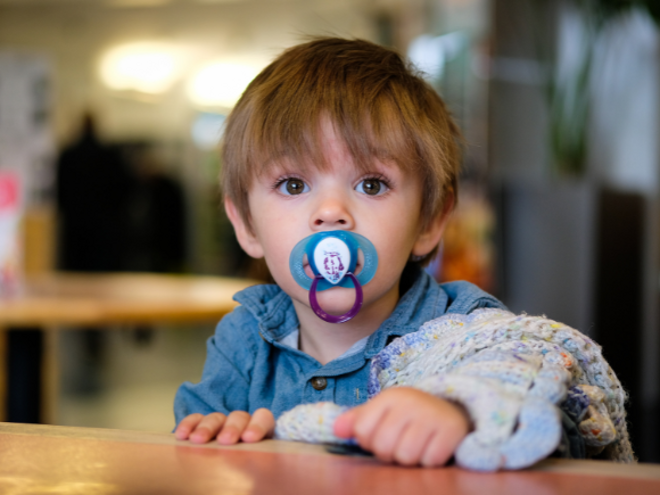
Ditching The Dummy: When and How to Wean Your Toddler Off Dummies
Are you looking for ways to help your child transition away from using a dummy? Weaning from a dummy is a common milestone for many parents, and it's essential to approach this process with patience and understanding.
The use of dummies is a fairly common practice, as many babies find the sucking quite settling. Although dummies are an effective soothing mechanism for young babies, it is recommended they don’t start in the first 4-6 weeks or until breastfeeding is well established. It is also recommended that they are eventually weaned off them by the time they have any permanent teeth erupting through the gums. Eventually getting rid of the dummy is important as prolonged use after this time can cause issues with teeth positioning and alignment.
Why are dummies used with young babies?
Dummies, also known as pacifiers or soothers, can provide several benefits for babies. Some baby’s have a particularly strong sucking urge and find sucking on a dummy outside of feeding very settling.
Positive reasons for dummy use for babies below the age of 1
- Soothes babies who struggle with self-settling during sleep time;
- May reduce the risk of sudden infant death syndrome (SIDS) if used consistently;
- Provide a calming effect and help soothe a fussy or colicky baby, offering them a sense of comfort;
- The use of a dummy during procedures like vaccinations or medical interventions may help provide temporary distraction and comfort.
Why is it important to wean babies off the dummy?
Understanding their role in a child's development can help you determine when to ditch the dummy.
Potential negative effects of using a dummy
- From birth – Use of a dummy before breastfeeding is well established may interfere with prolonged successful breastfeeding. It is not recommended to start using a dummy before 4-6 weeks of age if your baby is breastfed. Formula-fed infants may start using a dummy from birth.
- From 1 year of age – Most children start talking and using single words to communicate between the age of 12-18 months. Prolonged or excessive use of a dummy beyond one year of age may interfere with their speech development. It’s hard to talk and form words with a dummy in their mouth.
- From 2 years of age – Most toddlers have all their baby teeth through by 2-3 years of age. Weaning from a dummy is recommended well before this stage as prolonged use beyond this may cause your child’s teeth to be misaligned and protrude outward unnaturally.
- From 4 years of age – Late toddlerhood comes with much independence. Still using a dummy at this age is likely to be difficult to reverse and ditching the dummy may become problematic with dummy withdrawal symptoms, tantrums, and some potential long-term dental issues. There may even be some embarrassing social implications as well if they are still using a dummy by school age.
Tips for how to wean a baby off the dummy
Like many things in parenthood, there isn’t always one clear method that will ensure the outcome you might want for your child. Choosing the right time to wean your child off a dummy is crucial. Each child is different, so it's essential to look out for signs that they are ready. Don’t be too hard on yourself if your child is finding it more difficult than others to wean off their dummy.
Common reactions from babies who have their dummy removed or weaned away
Weaning from a dummy can present several challenges. It's important to remember that every child is different, and what works for one may not work for another. While it might be difficult to watch your little one in additional distress over losing their dummy, there are strategies you can try to make the transition smoother.
- Resistance and tantrums: It's natural for children to become attached to their dummies, as they provide comfort and security. When attempting dummy weaning, your child may resist and express their displeasure through tantrums. It's essential to be patient and understanding. Gradual weaning is often the most successful approach. Start by limiting the use of their dummy to specific times, such as naptime or bedtime. This helps your child associate the dummy with sleep, making it easier to eventually eliminate.
- Excessive crying: If your child has relied on their dummy as a settling technique or comforter in stressful situations, removing it may understandably result in extra crying. It may take time for your child to adjust, but with gentle guidance and support, they will learn to soothe themselves without relying on the dummy.
- Trouble self-settling to sleep: It is often recommended if you use a dummy, then you should consistently use it during sleep time in the first year. So, it makes sense that removing that soothing device may come at the cost of sleep as your little one’s ability to self-soothe and get themselves back to sleep if they wake is now un-aided. Additional emotional support and use of alternative comforters may be all your little one needs.
- Behavioural adjustments: It's not uncommon for them to feel more irritable or fussy during the day. This is a normal reaction to the loss of a familiar soothing object, and it should improve over time. To help your baby cope with these behavioural changes, it's important to offer alternative ways to self-soothe. Encourage the use of a comfort toy or introduce other calming techniques such as gentle rocking, swaying, or a warm bath before bedtime. These activities can help your little one relax and feel secure.
Ways to make weaning off a dummy easier for your child
- Introduce alternative soothing methods. This can include providing a comfort object, such as a soft toy or blanket, that your child can cuddle with instead of the dummy.
- Offer extra attention and comfort through cuddles, gentle rocking, or soothing lullabies to help ease the transition.
- Choose the right time. Getting the timing right in your toddler’s routine may make all the difference.
- Try limiting dummy use to key times like bedtime, and be consistent;
- Identify times of the day your little one is less interested in their dummy and be consistent with not offering it to them;
- Keep their dummy out of sight during the day so they’re not reminded it’s an option.
- Choose the right method. When it comes to dummy weaning, consider your child's individual development and readiness when choosing the right way for them. Regardless of the method, it's important to approach the process with patience and understanding. There are three main approaches:
- Gradual weaning techniques: One approach is to gradually reduce your child's dummy usage over time. Start by limiting the dummy to specific times, such as naptime or bedtime, and gradually decrease its usage. This method allows your child to adjust gradually and reduces the chances of resistance.
- Cold turkey method: Another strategy is to remove the dummy abruptly. This approach may work for some children who adapt well to change. However, be prepared for potential resistance or tantrums initially. Provide extra comfort and reassurance during this adjustment period.
- Involving your child in the process: Engaging your child in the decision-making process can make them feel empowered. Explain to them why it's time to give up the dummy and involve them in choosing a special way to say goodbye to it. This could involve a goodbye ceremony or allowing them to donate their dummy to a baby or child in need.
- Consistency is key. Weaning off a dummy is a process that requires support, patience, and consistency. Every child will be different, and it may take some time for your little one to fully adjust to life without a dummy. Try to maintain a calm and nurturing environment to support their transition.
If you have any concerns or need further guidance, consult with your child's healthcare professional.
Frequently asked questions about how to wean off a dummy
How to get rid of a dummy?
Getting rid of a dummy (pacifier) can be a gradual process. Start by limiting its use to specific times, like bedtime. Introduce comfort alternatives like a stuffed animal or blanket. Gradually reduce dummy time until it's no longer needed. Offer comfort and reassurance during the transition. Be patient and consistent.
When to wean off dummy?
The ideal time to wean off a dummy varies for each child. For most, starting the process around 12 months is recommended to prevent prolonged use. It is ideal if your child is completely weaned off the dummy by the time all their teeth are through, so it doesn’t affect their teeth and gum positioning. Follow your child's cues and consult with a healthcare professional for personalised guidance.
How to wean a baby off a dummy at night?
To wean an older baby off a dummy at night, gradually reduce reliance by offering comfort alternatives like a stuffed animal or soothing music. Start by removing the dummy once your baby is drowsy and gradually work towards eliminating it altogether. Consistency, patience, and providing extra comfort during the transition can help ease the process.
How long does it take to wean off a dummy?
The time it takes to wean off a dummy varies for each child. It can range from a few days to several weeks. Consistency, patience, and gradual reduction in dummy use can help facilitate the process. Remember, every child is different, so be flexible and follow your child's pace.
What is the average age to get rid of a dummy?
The average age to get rid of a dummy (pacifier) varies, but it is recommended to be completely weaned off the dummy by the time they have all their teeth through, which is around 2-3 years of age. However, it's important to consider your child's individual needs and readiness. Consult with a healthcare professional for personalised guidance on when and how to wean off the dummy.
Can you go cold turkey with a dummy?
Going cold turkey with a dummy is one option, but it may be more challenging for some children. Abruptly removing the dummy can cause distress, which may delay the process quite a bit. Gradual weaning is often recommended, but if you choose to go cold turkey, be prepared for potential resistance, and provide extra comfort and support during the transition.
Sources:
Rednose Website. Accessed at https://rednose.org.au/article/using-a-dummy-or-pacifier
Pregnancy, Birth and Baby Website. Accessed at https://www.pregnancybirthbaby.org.au/dummies-and-comforters
Raising Children Website. Accessed at https://raisingchildren.net.au/newborns/sleep/settling-routines/dummies





